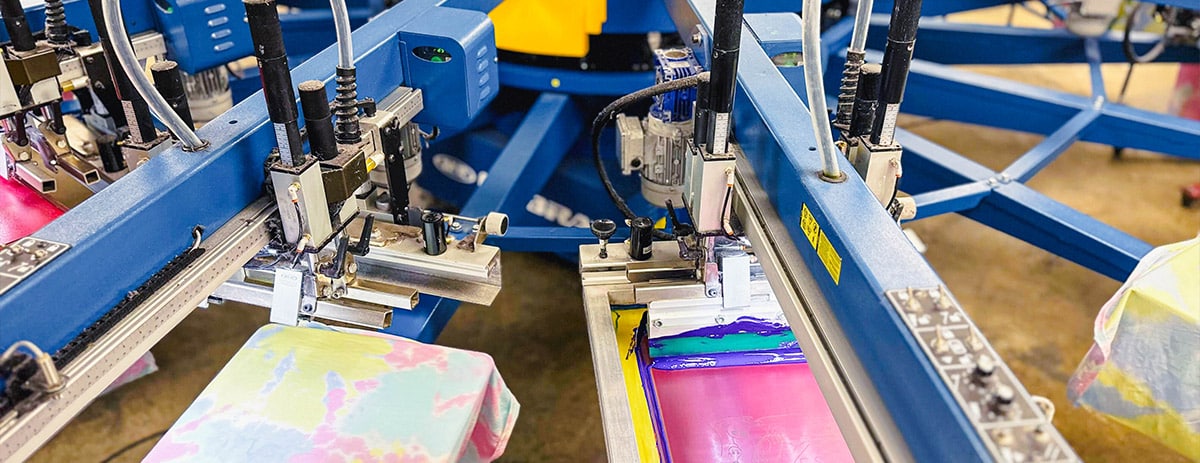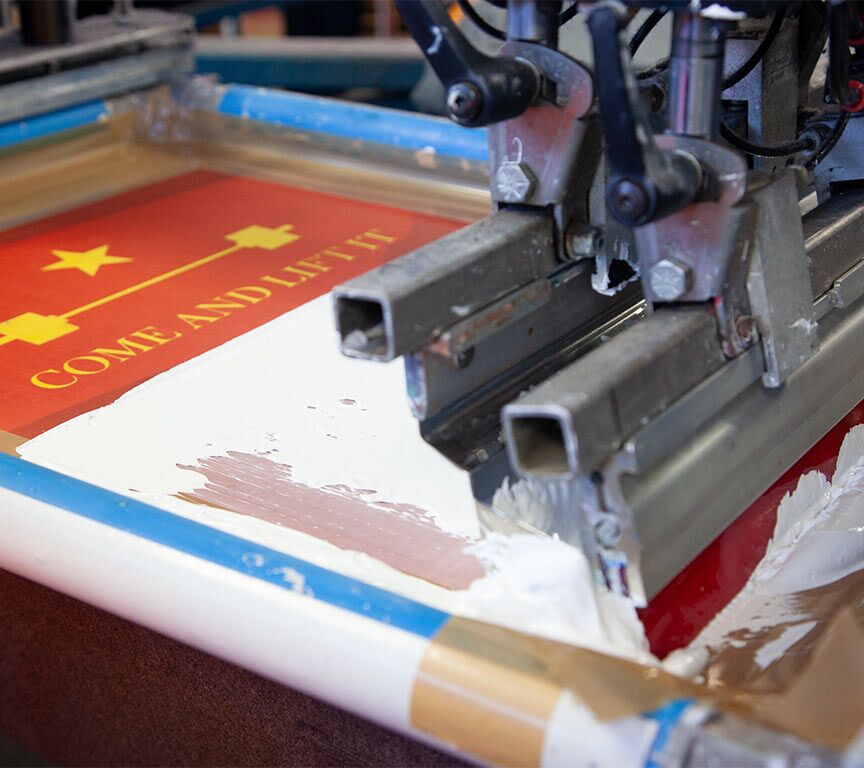Silk Screen Printing for Bold and Lasting Designs
Silk Screen Printing for Bold and Lasting Designs
Blog Article
Display Printing Uncovered: Whatever You Need to Learn About Tee and Garment Printing Methods
If you have actually ever questioned exactly how those lively styles wind up on your favored t-shirts, you're in the ideal place. Screen printing is a fascinating approach that incorporates art with strategy, providing limitless possibilities for imagination. Comprehending the principles, from devices to ink selections, can substantially impact your outcomes. Ready to explore the important components that make screen publishing an art type? Let's uncover the details that can boost your jobs.
The Fundamentals of Screen Printing: How It Functions
When you dive into screen printing, you'll discover it's both a science and an art. At its core, display printing involves producing a pattern, or display, that enables ink to pass with only in details areas.
Next, you'll mix your inks and prepare your printing surface area. Position the screen over the textile, then make use of a squeegee to press ink with the screen onto the garment. This process calls for precision, as you desire clear, lively prints. After printing, you'll cure the ink with warm, ensuring it sticks to the fabric and lasts with washes. Each action is vital, and grasping them will raise your screen printing abilities, changing easy garments right into unique, meaningful pieces.
Sorts Of Display Printing Methods
When you realize the basics of display printing, it's time to check out the different methods that can elevate your layouts. One prominent approach is standard display printing, where ink is pressed via a stenciled screen.
If you're aiming for fine details, consider discharge printing. This strategy removes color from the material, leaving a soft, vintage look. Another choice is plastisol printing, understood for its durability and vivid colors, making it a preferred for many brand names. Lastly, explore halftone printing to create slope effects and elaborate styles. Each strategy has its special appeal, so do not hesitate to attempt them bent on locate what fits your design best!
Vital Devices for Screen Printing
To attain magnificent outcomes in display printing, having the right equipment is fundamental. Initially, you'll require a sturdy screen printing framework, which holds the mesh that transfers your design onto the garment. Next, buy top notch mops; these are vital for applying ink evenly across the display. You'll additionally call for a great exposure unit to develop your displays, along with a washout booth for cleansing them after usage. A dependable warmth resource, like a conveyor clothes dryer or heat press, is essential for treating your prints to guarantee long life. Do not forget an appropriate office, outfitted with tables and storage space for your supplies. Finally, protective equipment, such as handwear covers and masks, will certainly keep you secure from chemicals and inks. With the right devices, you'll be well on your means to generating professional-quality prints.
Picking the Right Inks and Products
When choosing inks and products for screen printing, you need to think about the sort of ink that works best for your job. Think concerning material compatibility to guarantee your layouts look last and great long. Likewise, check out environmentally friendly ink alternatives to make your printing procedure a lot more sustainable.
Sorts Of Display Inks
Selecting the best screen ink is vital for attaining vivid, durable prints that meet your job's demands. There are several kinds of screen inks to analyze. Specialized inks, such as glow-in-the-dark or metallic, can add special effects to your layouts.

Textile Compatibility Factors To Consider
Recognizing textile compatibility is vital for accomplishing top notch display prints, particularly because various products respond distinctively to various inks. When choosing inks, take into consideration the textile kind-- cotton, polyester, or blends. For cotton, water-based inks work well, offering soft qualities and breathability. Polyester, on the various other hand, often calls for plastisol inks for much better adhesion and dynamic colors. If you're publishing on blends, you may need to utilize a combination of both types. Constantly evaluate your inks on example fabric to guarantee they stick appropriately and maintain color stability. Additionally, remember that material weight and appearance can influence the last result, so picking the ideal ink and material combination is vital for your task's success.
Eco-Friendly Ink Options
Eco-friendly inks are ending up being a preferred choice for display printers that wish to lessen their ecological influence while keeping high quality. When choosing inks, consider water-based inks, which are much less dangerous and easier to clean up compared to typical solvents. These inks bond well with materials, supplying vibrant results without hazardous chemicals. You might additionally explore eco-solvent inks that utilize less unpredictable organic substances (VOCs), making them a more secure choice for both your wellness and the world.
Additionally, search for inks made from eco-friendly sources, such as soy or vegetable-based choices. By selecting the right inks and products, you'll not just produce sensational designs however additionally contribute to a much more lasting printing procedure. Make the button, and your prints will mirror your commitment to the setting!
Preparing Your Design for Display Printing

File Style Needs
To assure your layout looks dynamic and sharp on textile, you'll need to pay close focus to submit format requirements for screen printing. Make certain your style has a transparent background to protect against undesirable white sides on your prints. Maintain color modes in mind; CMYK is standard for display printing, so transform your RGB creates as necessary.
Shade Separation Strategies
Color separation is an important step in preparing your style for screen printing, and grasping it can greatly boost your print quality. You'll require to damage your design into individual shades, as each shade calls for a different screen throughout printing. This precision not just assures precise color representation but likewise streamlines the printing process.
Resolution and Dimension
Accomplishing the most effective results in display printing starts with assuring your design has the best resolution and dimension. Preferably, your art work must be at least 300 DPI (dots per inch) for sharp, clear prints. Your final product might look pixelated and unprofessional. if you utilize lower resolution.
When it comes to dimension, take into consideration the measurements get more of your print location. Design your artwork to match the last print size, preferably creating it in the real dimensions you'll be publishing. This way, you'll prevent any unforeseen scaling issues.
Constantly inspect your design in both vector and raster styles. Vector graphics can be scaled without losing top quality, making them suitable for screen printing. Preparing appropriately will ensure your design looks remarkable on every garment!
Step-by-Step Display Printing Process
Screen printing is a vibrant procedure that enables you to produce vivid styles on numerous surfaces. To get going, you'll need a display, emulsion, and your picked ink. Prepare your screen by cleansing it extensively. Next off, use the emulsion evenly and allow it completely dry in a dark location. When dry, expose your screen to light with your design positioned on it, which will certainly harden the emulsion where the light hits, creating a stencil - screen printing kit.
After washing out the unexposed emulsion, your display prepares. Set it up on your printing surface area and align your garment under it. Put ink onto the display and utilize a squeegee to push the ink via the pattern onto the material. Lift the screen carefully and let the print completely dry. Heal the ink utilizing warm to ensure toughness. That's it! You've successfully screen published your design.
Tips for Effective Screen Printing Projects
While you're diving into your display printing tasks, keep in mind that preparation is vital to success. Start by collecting all your products-- inks, garments, mops, and screens. A clean work area helps avoid undesirable mistakes, so clean up prior to you begin.
Following, verify your art work is high-resolution and properly sized for your garment. Test your screen for correct exposure and clean it thoroughly to avoid spots. When blending your inks, comply with the producer's standards to accomplish the appropriate consistency.
Throughout printing, use also pressure with your squeegee for consistent results. Do not rush; take your time to confirm each print satisfies your criteria. After printing, let your garments dry totally before taking care of or packaging them.
Last but not least, constantly maintain an example of your benefit future recommendation. By doing this, you can assess your progress and enhance your techniques over time. Delighted printing!

Regularly Asked Questions
The length of time Does It Take to Establish a Display Printing Job?
Establishing up a screen printing task commonly takes around half an hour to an hour. You'll prepare the screens, mix inks, and readjust journalism. The moment varies based upon intricacy and experience, so remain organized!
Can I Publish on Different Fabric Keys In Utilizing the Exact Same Strategy?
Yes, you can print link on different fabric types using the exact same technique, but you'll need to adjust your settings and inks. Some materials take in ink differently, so exploring guarantees the most effective outcomes for each and every material.
What Prevail Mistakes to Prevent in Display Printing?
When display printing, prevent typical errors like utilizing the wrong ink, overlooking correct exposure times, or avoiding pre-press checks. Constantly test your arrangement and keep clean displays to ensure top quality results each time.
How Can I Appropriately Tidy and Keep My Display Printing Tools?
To appropriately clean and preserve your display printing equipment, you should frequently wash screens with appropriate solvents, check mops for wear, and guarantee all devices are stored dust-free and dry. Consistency avoids pricey fixings and enhances performance.
Is Screen Printing Eco-friendly Compared to Various Other Techniques?
Screen printing can be much more eco-friendly than other reference methods, especially if you use water-based inks and eco-conscious products. By picking lasting products and practices, you decrease waste and minimize your effect on the world.
Screen Printing Uncovered: Every Little Thing You Required to Know About Tee Shirt and Garment Printing Methods
At its core, screen printing includes developing a pattern, or display, that enables ink to pass via only in particular areas. Setting the screen over the textile, then use a squeegee to press ink through the display onto the garment. One preferred method is conventional display printing, where ink is pressed through a stenciled screen.When picking inks and products for screen printing, you need to take right into account the type of ink that functions ideal for your task.
Report this page